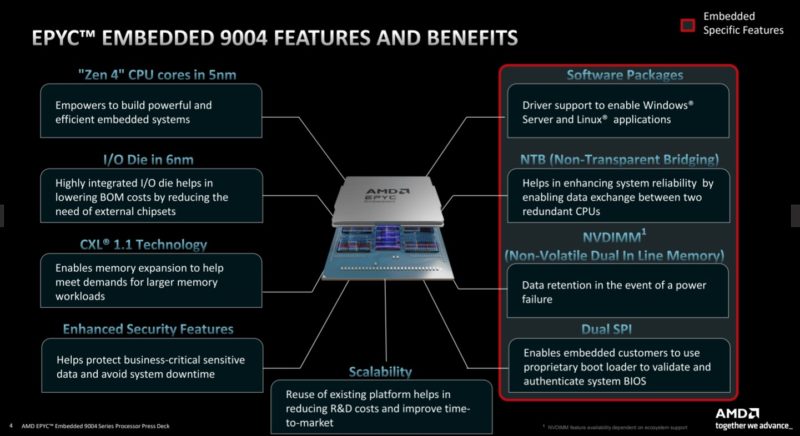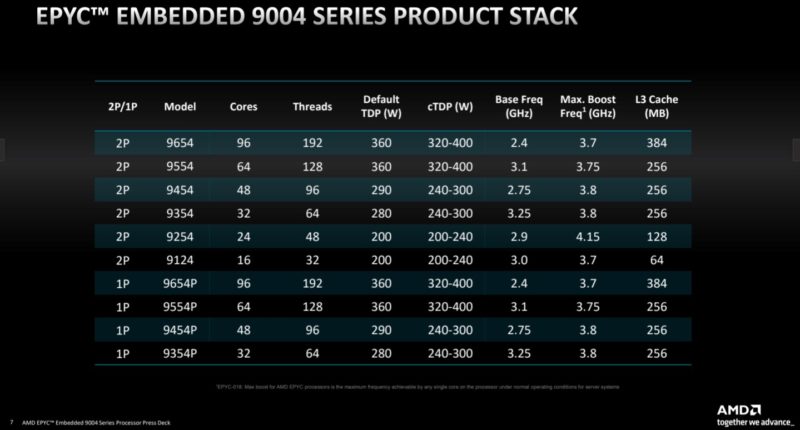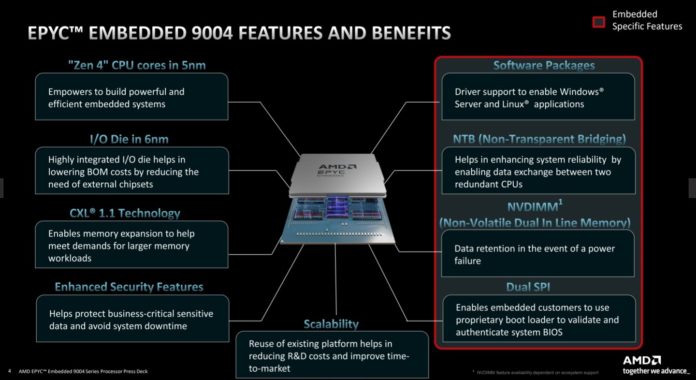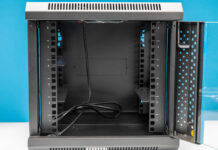This is one of the bigger letdowns of the week. For Embedded World, AMD has a new part. This is not the re-kindling of a Xeon D competitor, and we are still not sure what and why these parts are being named and launched as they are. Still, we decided to cover that there is a new AMD EPYC 9004 series.
AMD EPYC Embedded 9004 Series Launched
If you want to learn more about the AMD EPYC 9004 “Genoa”, you can see our in-depth coverage here: AMD EPYC Genoa Gaps Intel Xeon in Stunning Fashion. We also have a video for that piece:
The AMD EPYC Embedded 9004 series seems to be the same AMD EPYC 9004 “Genoa” part with a few new features.

That list seems a bit thin. For example:
- “Driver support to enable Windows Server and Linux applications” as an Embedded Specific Feature feels odd since the AMD EPYC 9004 “Genoa” supports Linux and Windows.
- NTB or Non-transparent bridging support is often used in places such as with HA storage arrays.
- NVDIMM support is something that we have seen in mainstream server processors for some time, so it is strange why it would be an Embedded Specific Feature
- Dual SPI makes sense in this market
Still, it feels like this is a fairly minimal set of differentiating features. Here is the SKU stack:

One will quickly notice that the model numbers resemble what we have seen before. The AMD EPYC 9654 can be seen on the cover of the Genoa video above, but the AMD EPYC Embedded 9654 also has 96 cores but is a different family.
One difference, however, that is more unique is the lifetime of SKUs. The new parts are targeted to be available for seven years.
Final Words
Our sense is perhaps that AMD has new longer availability OPNs so that an embedded customer can build an embedded system with longer product lifecycles and that was perhaps the big driver of this offshoot line. After making that decision, it seems like AMD is trying to force a bit more segmentation.
On the other hand, for the embedded market, especially those applications with higher power and thermal headroom levels, the AMD EPYC 9004 “Genoa” is a strong part so this is the case where a new set of per-socket performance capabilities and features will be available to a new market.





Yikes, minimum 200W TDP. And here I was, hoping they’d update the 4 year old 30W 3201 to current gen / Zen 4. That would make a smokin’ firewall or storage appliance. I guess they’ve propelled into a new segment of appliances altogether here or am I missing something?
Seems like a product targettet for storage products like SAN, filers or object. Expecially those with NVMe and perhaps CXL in the future.
I’m guessing they’re eventually going to base embedded products off the smaller platform – SP6 then make fully soldered versions of it?
And fully socketed lineups make embedded far nicer anyway even if they don’t
Given how niche epyc embedded was for them I don’t see why they would return to making wimpy 30w models just to compete with Intel at all fronts
I don’t see why 30w parts are wanted or even needed anymore, at least for the Zen-architecture. I mean, set any power limit you want and the CPU will adjust itself to that limit. Of course, you’d not get the same frequency, but this is a problem that AMD could easily fix by providing a set of power/guaranteed frequency values. Also I’d say that for embedded devices this should be less of a problem since the application is a known quantity and as such the performance requirements are too. This should enable the manufacturer to set an as low as possible power limit without endangering performance.
Wow. Yeah. Definitely a dissapointment. Been waiting for a successor to the 3000s series, and this is basically the nail in the coffin of that ever happening. Here’s our embedded line, same as the other line but with more solder…
@Jorik There will be a price difference between a 16-core processor that’s capable of running at 200W and limited to 30W, and a 16-core processor that can only run up to 30W. I personally would love to see some affordable 128+ core sub-GHz processors.
I don’t see why it would be particularly niche. With 25Gb networks now within reach for most/many, and 2.5Gb the new 1Gb, a 30W edge appliance based on current gen, but with ECC ram and a bunch of PCI lanes for NICs and I/O would create absolutely stunning firewalls or compute nodes. Fanless. The 3000 series is still kickin’ but getting old. Meanwhile Intel seems to continue to invest in this space. I think it’s a shame AMD are dropping it (seemingly).
It’s a shame to you but AMD has to prioritize the important markets to them first.
They had their hands in a lot of markets then because they were fledgling and they weren’t particularly good at some of them in particular embedded but with zen 4 being fairly new they have to make sure they’re able to serve the server market demand now that they’re on top.
Even epyc embedded took some time to come out back then.
> and they weren’t particularly good at some of them in particular embedded
The Zen 1 embedded was particularly good, though. They were best in class in many dimensions for a while after they came out: https://forums.servethehome.com/index.php?threads/supermicro-m11sdv-8c-ln4f-review-amd-epyc-3251-mitx-platform.23626/